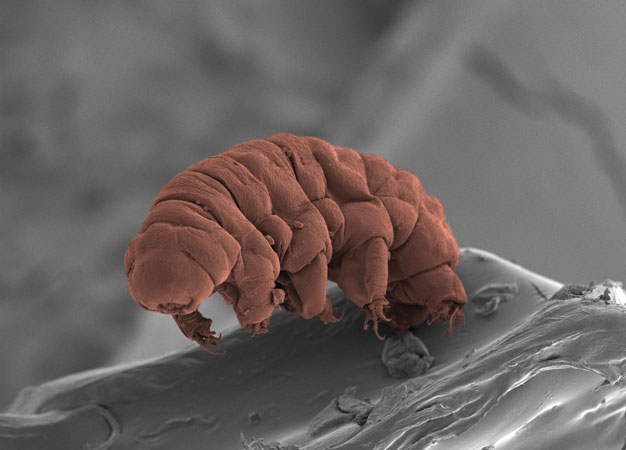DNA analysis shows how water bears survive extreme conditions, yet leaves evolutionary origin unclear
Published online 31 January 2018

The genomes of Ramazzottius varieornatus (pictured) and another tardigrade species reveal how these hardy creatures persist in extreme environments.
© 2018 Hiroki Higashiyama and Kazuharu Arakawa, Keio University
Tiny water-dwelling creatures known as tardigrades can survive for years in the face of extreme temperatures, radiation exposure, desiccation, and even the vacuum of space. How these microscopic animals evolved and why they are invincible have long puzzled scientists.
A genomic study co-led by Keio University researchers sheds light on how these hardy beasties withstand rapid desiccation, freezing, and other environmental trials, and provides new clues on the contested evolutionary history of tardigrades, also known as water bears or moss piglets1.
The findings hold relevance beyond this particular quirk of natural history, says Kazuharu Arakawa from Keio's Institute for Advanced Biosciences. "These mechanisms to withstand significant cell damage may lead us to better understand the integrity of human cells on stress and damage," he says.
What's more, insights about how tardigrades endure dehydration may help scientists develop more stable enzymes, vaccines, and cell therapies that can be freeze-dried and stored at room temperature. "We foresee significant impact on the preservation and logistics of these products," Arakawa says.
Arakawa's team at Keio joined forces with Mark Blaxter and his group at the University of Edinburgh, UK, to decode the full genomes of two tardigrade species, Hypsibius dujardini and Ramazzottius varieornatus. Together, they analyzed their gene expression patterns at various developmental stages, including the desiccated 'tun' stage, and identified a number of genes related to extreme survival abilities and other genes involved in stress responses that were shared by both species. They also found many genetic differences that could explain why H. dujardini takes about a day to become dormant while R. varieornatus can do so in less than 30 minutes.
The researchers then explored whether the genomes could resolve the place of tardigrades in the evolutionary tree of life. For many years, biologists debated whether tardigrades are more closely related to nematode worms or arthropods. Their four pairs of stubby legs, each tipped with claw-like bristles (see image), indicated arthropods were the nearest kin, but molecular biology suggested that they might be closer to nematodes.
However, genomic comparisons were not definitive. Analyses of gene sequences supported the tardigrade−nematode link, whereas studies of rare genomic changes supported the tardigrade−arthropod one. "We still have contrasting evidence for phylogeny, and it remains unresolved," Arakawa says.
"But our results clearly show that the tardigrade−nematode relationship cannot be immediately rejected," he adds, noting that additional genomes from related critters should help resolve this evolutionary enigma.
About the researcher

Kazuharu Arakawa― Associate Professor
Faculty of Environment and Information Studies, Keio University
Kazuharu Arakawa is based in the Institute for Advanced Biosciences, a cutting-edge bioscience research institute, which Keio University has established in Tsuruoka City, Yamagata Prefecture. He earned his MA and PhD in Bioinformatics from Keio University in 2004 and 2006. His research interests range from the extremophile biology of tardigrades through to the biophysics of spider silk.
Links
Reference
- Yoshida, Y., Koutsovoulos, G., Laetsch, D. R., Stevens, L., Kumar, S., Horikawa, D. D. et al. Comparative genomics of the tardigrades Hypsibius dujardini and Ramazzottius varieornatus. PLOS Biology 15, e2002266 (2017). | article